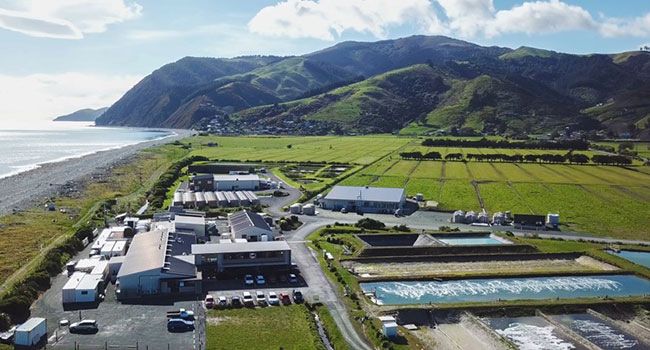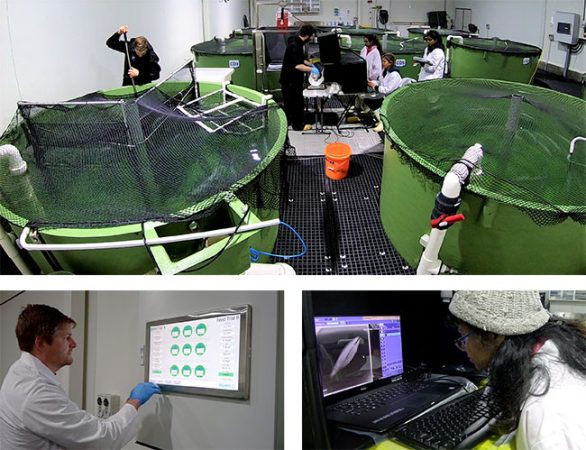
Features
Research
Systems
Technology
Water Quality Week
RAS is key to New Zealand’s blue economy
September 5, 2022 By Gareth Nicholson
 Aerial view of the Cawthron Institute in Nelson, New Zealand. Photos: Gareth Nicholson, The Cawthron Institute
Aerial view of the Cawthron Institute in Nelson, New Zealand. Photos: Gareth Nicholson, The Cawthron Institute Cawthron Institute is New Zealand’s largest independent science organisation. It focuses on world-class science aimed at restoring and protecting the environment and supporting the sustainable development of New Zealand’s blue economy.
The Cawthron Aquaculture Park is situated just outside of Nelson, and acts as a research and technology hub for the aquaculture sector. The Park houses multiple research laboratories and culture systems including micro and macro algae culture facilities, shellfish nurseries, commercial shellfish hatcheries and several recirculating aquaculture systems (RAS) geared toward finfish research.
In 2014, a collaboration between the Cawthron Institute and the New Zealand salmon farming industry was initiated to further understand the largely understudied king salmon and assist with industry advancement.
Chinook or king salmon (Oncorhynchus tschawytscha) is currently the only finfish species farmed commercially in New Zealand. The salmon farming industry is comprised of several hatcheries, sea pen farms and freshwater grow out farms, all based in the South Island.
Although small in global terms, the industry produces more king salmon than anywhere else in the world, and is home to the world’s only freshwater farmed king salmon. These unique industry attributes mean that global research and industry advancement is not always transferable, particularly due to its focus on Atlantic salmon.
The collaboration led to the construction of Cawthron’s first finfish RAS, containing nine 5,000-litre tanks, designed to conduct feed trials and growth performance research. Following the success of this project, the Finfish Research Centre (FRC) was opened in 2018 which houses six additional recirculating systems, designed with research in mind.
The two main FRC trial rooms house eighteen 8,000-litre tanks which can be isolated as four different RAS systems or combined as a single research system. A separate room houses nine 3,000-litre tanks which can be combined or separated into two recirculating systems.
Cawthron’s systems were designed and constructed with the assistance of Australian-based Fresh by Design. Standard RAS technologies that are incorporated into all systems include: Faivre drum filters, RK2 protein fractionators, UltraAqua UV units, customized moving bed bioreactors, degassing columns, oxygen cones and heat pumps capable of maintaining temperatures of from 7 C to 27 C.
Ozone units supply the fractionators and dosing capabilities include pH and oxygen systems. To allow flexibility and to ensure that water quality parameters are maintained to research standards, technology components in these systems have been intentionally oversized. Each system’s volume can be turned over every 25 minutes and filtration components can handle feed rates of three per cent body weight per day at a biomass of up to 35 kg/m3.
Culture tanks incorporate a dual drain system and tank side swirl separators for uneaten pellet collection. Uneaten feed recovery allows us to calculate feed conversion data based on what has been consumed rather than what has been fed. This provides valuable insight into overall performance data and biological FCR potential.
What really sets these systems apart is the level of monitoring and control which they incorporate. To conduct word-class aquaculture research, system parameters need to be accurately maintained to fine margins and water chemistry needs to be consistent across all culture units.
OxyGuard probes are installed inline to monitor the return water conditions in each system. Temperature, pH, dissolved oxygen, oxidation reduction potential and salinity are monitored through system probes. Data is fed back to a programmable control (PLC) and monitoring system which logs data and allows for parameter adjustment using setpoints and dosing systems. System temperatures can consistently be maintained within 0.1 C of a setpoint if required.
In individual culture tanks, dissolved oxygen levels are monitored and controlled to account for tank-based differences in oxygen demand. Tank flow rates and current velocity can be manipulated manually and monitored. Tank room photo period and light intensity is also controlled through the PLC.
A world-class supervisory control and data acquisition system (SCADA) has been developed in-house, allowing us to access real-time or historical system data and adjust remotely. This system also provides alarm capabilities which are linked to all monitored parameters and RAS equipment.
To date, valuable research has been performed using the Cawthron finfish systems that continues to play a key a role in advancing our knowledge of king salmon and its performance in an aquaculture environment. Baseline knowledge has been established about its physiology, health, feeding regimes, feed efficiency and dietary requirements through all life stages, rearing salmon from smolt to harvest size under research conditions.
Farm diets have been further optimised for fish performance while improving product quality and feed sustainability. Significant research effort has been focused on understanding the feed efficiency of king salmon in terms of behaviour and performance under different culture conditions.

The tank room at Cawthron Institute’s Finfish Research Centre. (Photos: Cawthron Institute)
For instance, how does salmon feed efficiency respond to changes in temperature, salinity, current velocity, with different feeding regimes and feed out practises and at different stages of the growth period or life cycle?
We have also developed a good understanding around which factors affecting efficiency can be genetically attributed or could be altered with improved farming practises.
Cawthron’s finfish systems have highlighted the benefits and reliability of using RAS for aquaculture research. Some of the more important of these being the ability to accurately maintain system parameters over longer periods of time and expose tanks in the same research systems to different parameters without adversely impacting trial outcomes.
We have successfully run long-term trials, through all ambient seasonal fluctuations without compromising trial parameters, and we have run performance analysis trials using four different temperatures simultaneously, without incurring system effects.
Challenge trials have also been possible on single research systems, testing the exposure limits of king salmon to different temperatures and dissolved oxygen levels. Most recently, we have intentionally introduced potentially harmful biofouling organisms into some culture tanks without affecting others in the same tank room. These studies and levels of control are simply not possible in open or flowthrough research systems.
Along with research benefits, these systems have provided a vital resource in the education and training of many staff and students in the operation of advanced aquaculture systems, and the animal husbandry techniques that are associated with them. These skills are fed directly into the aquaculture industry and are important for growth.
Industry involvement with these systems has allowed aquaculture companies to experience some of the benefits associated with RAS first hand. With a better understanding of the value of these systems, we are beginning to see some of New Zealand’s major salmon production companies look towards RAS as an opportunity for future development and incorporation into current production strategies. With the industry facing growing pressure from environmental variability, future growth in RAS development is expected in New Zealand.
Gareth Nicholson is the senior aquaculture technician specializing in finfish research at Cawthron Institute in Nelson, New Zealand. The institute (www.cawthron.org.nz) is an independent science organization conducting research in sustainable development.
Print this page